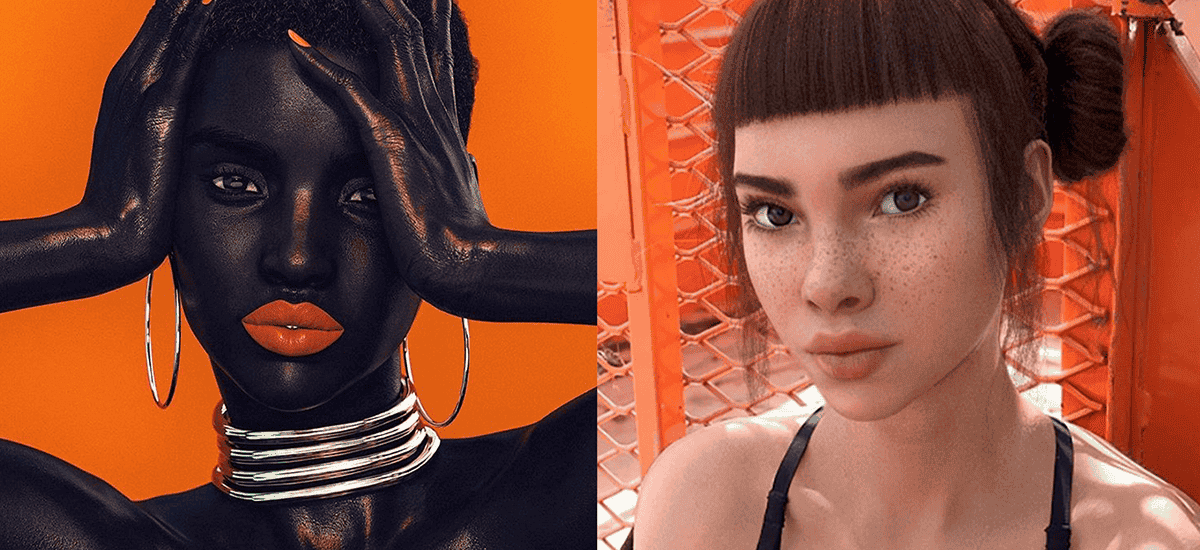- CGI Instagram and YouTube stars developed by AI tech companies on the rise
- Internet Matters today launches new advice for parents on how to protect their children and encourage them to think critically about virtual influencers
- 65% of parents concerned about lives portrayed in online vlogs give kids unrealistic expectations about real life
- 69% of parents admit they find it difficult to know whether certain vlogs are suitable for their kids
Parents are being encouraged to have a conversation with their kids about ‘picture perfect’ virtual influencers and the risks they may pose to their wellbeing including online manipulation.
It comes following an increase in the number of CGI stars appearing across the likes of Instagram and YouTube – who shows off an aspirational lifestyle.
A study carried out by researchers at the Toyohashi University of Technology showed humans are able to empathise with robots in a similar way to how they do with humans.
Brands using AI influencers can potentially use this empathy to help them monetise the engagement and manipulate users into buying their latest products.
In many cases, the AI influencers image has been designed by gathering data on trends and amalgamating those trends into one picture-perfect image – in a bid to harness popularity.
New research has found that two-thirds of parents (65%) have concerns that the lives portrayed in online vlogs give kids unrealistic expectations about real life.
While 69% of parents* admit they find it difficult to know whether certain vlogs or vloggers are suitable for their kids.
Tech organisations create virtual influencer accounts in a bid to cash in on social media trends and help raise awareness of brands among an online audience.
The computer-generated aspirational images posted by the virtual influencers often include portrayals of the perfect body or lifestyle that are unattainable.
Examples of virtual influencers with large followings across Instagram and YouTube include Blawko, Bermudaisbae, Lil Miquela and Shudu.
Internet Matters ambassador and psychologist Dr Linda Papadopoulos have warned of the potential ‘damaging effects’ virtual influencers can have on a child’s self-esteem, body image and understanding of ‘real life’.
She said: “The new iteration of the virtual influencer gives brands and corporations the ability to create posts that feature perfect men or women who can speak to a largely young audience at the click of a button.
“Parents need to equip their children with all of the information. Speak to your child about these accounts in the same way you would with a real-life influencer, encourage your children to think critically about what they are viewing.
“Get them to depersonalise these accounts by asking some key questions, who is creating these posts, who are they targeting, why are they wearing those clothes and promoting those products? Allowing your child to ask questions will highlight to them the manipulated nature of these accounts and images.”
CEO of Internet Matters Carolyn Bunting said: “Technology is evolving at a rapid pace and AI influencers are the latest way for tech companies to reach their target market.
“It’s essential parents get to grips with the latest emerging online trends and have regular, open and honest conversations with their children about what they see and consume online.
“Improving a child’s digital literacy and building their resilience is the best way to empower them to navigate their own online world both safely and responsibly.”
Internet Matters is encouraging parents to empower their children to think critically about what they’re consuming online and has created age-specific digital resilience guides.
Internet Matters has also devised tips for parents on how to protect their children from the digital manipulation of virtual influencers across the top online platforms including Twitter, Instagram, Facebook and YouTube.
- Go to the account – If your child comes across an image on their discovery page or on their timeline of an account they don’t know, make sure they are clicking through and viewing the main page of that person’s account.
- Check out bio – Encourage your child to look at the influencers’ Instagram bio, many of these virtual influencer accounts state that they are in fact ‘robots’ in their bio.
- Look beyond the ‘blue tick’ – Let your child know that just because they have a ‘blue tick’ signifying they’re verified by Instagram as a personality, it does not mean they are real. Advise them to read their description.
- Check if images are real – Scroll through the images on the account to get a better view of what’s real and what’s not. Once you view more than one photo, the fact that they are CGI-generated will become clear through appearance but also their robot-themed captions and hashtags.
- Explain why brands use AI account – Inform your child that these accounts have been created by a team of people to be used by brands. Discuss with them the purpose of these influencers and how and why they exist.
- Check profiles of influencers – Before your child engages with a tweet encourage them to click onto the virtual influencers profile in order to get more information about them.
- Look through influencer Twitter timeline – Remind them to look past just the one tweet and look at the person’s interactions with other accounts, often they will announce that they are a ‘robot’ further down their timeline.
- Discuss things that could be fake on these accounts – Go through these accounts together and discuss the aspects that appear real but are fake, such as the interactions between other accounts on their page.
- Talk about how these ‘digital influencers’ are created – Although these accounts can be fun, make sure your child knows that they are run by a team of people and are in fact part of a larger group of CGI influencer accounts, explain to them that they are often a tool to sell products or promote brands.
Youtube
- Discuss what to watch out for – For video, it’s much easier to see that these profiles are CGI-generated personas but it’s still important to talk to your child about who they are and highlight the fake nature of the content.
- Encourage kids to be critical of what they see – Sometimes these videos may include a real influencer and a CGI one, these videos are harder to detect at first glance. Encourage your child to look closely at the people in the video, do they look like a video game character in comparison to the other person in the video? Does their voice match up to their mouth movements?
- Make sure they know to ask if they are unsure – Let your child know they can always come to you if they are unsure whether or not the influencer featured is a real person or not.
- Talk about who’s in control of these ‘digital influencers’ – Remind your child that they are not interacting with one person but with a whole team of people who have created this content, encourage them to think critically around. the origin of the video and what it’s trying to convey (i.e. brand-led content trying to sell products).
- Help them understand the difference between official and unofficial fan pages – Speak to your child about the existence of fan page Facebook pages, let them know that there is a mixture of both official and unofficial fan pages and accounts.
- Encourage kids to check out who someone is before accepting the request – Ensure that your child doesn’t accept any requests from accounts without first exploring if any official accounts for this person exist.
- Discuss if they actively follow digital influencers – Speak to your child about who they are Facebook friends with and ask them if they are following any virtual influencer accounts and then check if they are following the official page.
- Encourage them to be mindful of the intentions of those running fan pages – If your child is a member of any virtual influencer fan pages, remind them that it could be run by anyone and is still not a safe space.
- Agree on digital boundaries on how and who they interact with online – Set boundaries on how many accounts they can be a member of and make sure they check with you before joining any new ones.
Notes for editors
*Research commissioned by Internet Matters, carried out by Trinity McQueen of 2,000 UK parents of children aged four to 16.
**Survey of 2,022 parents of children aged 14-16 years old in the UK
About Internet Matters
Internet Matters is a not-for-profit, industry-funded members body that helps families stay safe online, providing resources for parents, carers and educational professionals. It was established in 2014 by BT, Sky, TalkTalk and Virgin Media and its members include BBC, Google, Samsung, Three, Facebook, Huawei, ByteDance, Supercell and ESET. It is a member of the Executive Board of UKCIS (UK Council for Internet Safety) and an industry expert working with The Royal Foundation Taskforce on the Prevention of Cyberbullying, founded by the Duke of Cambridge. It works with partners from across the industry, government and third sector to raise awareness and provide advice on the issues affecting children in the digital age, including cyberbullying, screen time, digital resilience, extreme content, privacy and exploitation.
Media Contacts for Internet Matters
Katie Earlam
[email protected]
Media line: 07946146215





